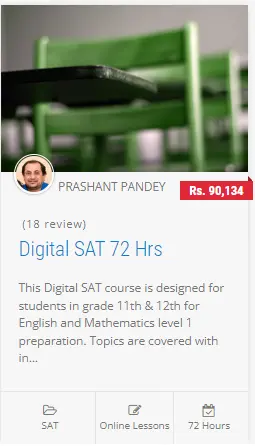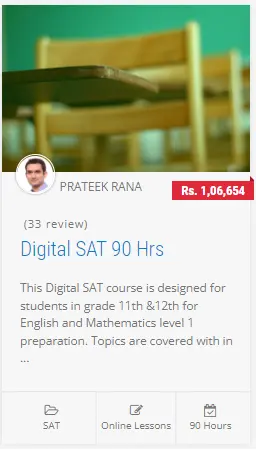Is the SAT Really Hard or An Easy One?
At times, the SAT seems like a nightmare. It has so much influence over the admission process, that even the thought of failing the test gets students goosebumps. The Digital SAT has a fearsome reputation among Students. And it surely is a bit scary. Now if you spend enough time studying and working on your weaknesses, the Digital SAT may not be that difficult.
If you think the SAT is difficult, the below guide which includes the best online preparation courses for Digital SAT will help you overcome the test’s challenges.
The SAT can be a bit scary for students. Many students struggle with the SAT. Sitting through a four-hour test with time constraints, reading passages, and tricky math problems can feel really tough. However, if you put in enough time to study and focus on your weak points, the Digital SAT might not be as difficult as it seems.
Understanding How Hard the SAT Test Can Be
The SAT can be tough, but don't worry too much! It's designed to challenge you in reading, math, and writing. Some find it a bit tricky, especially with time limits. However, with good preparation, like practicing reading and solving math problems, you can feel more confident. Remember, many students feel the same way, and by working on your skills, the SAT won't seem as difficult. Just take a deep breath, study smart, and you'll be better prepared for the challenge!
1. The Reading & Writing Section:
The reading & writing section involves a passage from something like an article, book, or another published text. It checks how well you understand and use evidence, know words, and analyze things in Social studies, History, and Science. This is done by looking at the main ideas, making sense of the information, and figuring out what the author is trying to say.
Your task is to read through it and find and fix any mistakes. The goal is to test how well you can express ideas, use proper punctuation, choose the right words, and construct sentences correctly.
2. The Math Section:
The Math section has different kinds of questions: somewhere you choose an answer from a list and others where you fill in a grid. There are also parts where you can use a calculator and parts where you can't. This section checks if you understand math ideas, how well you use them, and how comfortable you are with things like algebra, equations, data analysis, problem-solving, and geometry.
Explore the SAT Course Book a Free Trial Session
Factors That Make the SAT Harder
Here are a few factors that make the SAT a difficult test for many students. These include time pressure, challenging math concepts, difficult reading passages, and a high-stress environment.
Factor 1: Time Pressure
Time pressure is one of the key reasons, some students find the SAT difficult. The below table will give you a clear idea, of the amount of time you in hand to spend on one question in each section.
|
DIGITAL SAT EXAM STRUCTURE |
||
|
Section |
Reading and Writing |
Math |
|
Test length |
1st module: 25 operational questions and 2 pretest questions |
1st module: 20 operational questions and 2 pretest questions |
|
Time per module |
1st module: 32 minutes 2nd module: 32 minutes |
1st module: 35 minutes 2nd module: 35 minutes |
|
Total number of questions |
54 questions |
44 questions |
|
Total time allotted |
64 minutes |
70 minutes |
|
Average time per question |
1.19 |
1.59 |
Note: The time per question mentioned in the Reading and Writing is excluding the time spent on reading the passages.
Factor 2: Unfamiliar Math Concepts
As discussed earlier, the major part of the SAT syllabus comes from the first two years of your high school. There might be some questions about advanced maths concepts like basic trigonometry, which may seem problematic. However, you can work on these by revisiting them time and again, to be ready to answer these questions in a high-pressure testing environment.
Factor 3: Challenging Reading Passages
Passages used on the SAT are all excerpts from real published texts. And the language used in those is a bit old-fashioned and hard to understand. If you’re not an avid reader, you might need to work on your reading skills before taking the test. As you might waste more than the required time in the reading and writing section for reviewing the passages.
Factor 4: High-Stress Levels
One more major reason for the SAT to be harder is the impact it has on admissions. This pressure creates tension and gets students super worked up about it. Colleges rely on these scores heavily and most of the judging is basically done on these. Hence, students feel the stress of passing the test, which at times creates an opposite effect.
So, learning to cope with stress is the most important thing for students to make the SAT process more manageable.
4 Factors That Make SAT Easier
There are also some aspects of the SAT that can make it seem like an easy test compared to some of the exams you’ve taken in your classes. Here are a few of the most prominent factors.
Factor 1: Structure and Types of Questions
SAT structure is always the same. First is Reading; followed by Writing and Language; followed by Math. You never have to worry about something different coming your way in terms of structure.
This also applies to the types of questions asked in the test. They’re almost in the same format that was used in earlier years.
Factor 2: No Memorization
Reading and Writing sections have questions based on reading comprehension and the Maths sections have questions based on formulas. Hence, you do not have to spend time memorizing anything in detail.
Factor 3: Almost All Multiple Choice
In terms of question structure, there are operational questions and pretest questions in both the English and Mathematics sections.
Factor 4: No Negative Marking
There are instances where you have to guess a few answers here and there. SAT does not deduct marks if any of your answers are incorrect. So, If you truly can’t decide between two choices or are totally stumped, just make a random guess. Your main goal should be to answer all questions.
Ways to Make the SAT Less Stressful
The SAT is a challenge, but with the right approach, you can make it more manageable and increase your chances of success.
1. Practice Tests are Essential:
The SAT can be confusing and overwhelming because students often don't know what to expect. The test format and time constraints can make it seem challenging. To overcome this, it's crucial to take plenty of practice tests. By doing official SAT practice tests, you become familiar with the exam content. This helps you read efficiently, maintain speed, and stay calm during the actual test.
2. Review and Fix Errors:
After taking a practice test, it's important to analyze it. Look at the questions you got wrong and understand how to solve similar ones in the future. With each practice session, you'll get better at the material, covering all the concepts until you've mastered them.
3. Use Elimination Process:
During the SAT exam, you have a limited amount of time. Instead of spending too much time on a single question, it's better to quickly look at all the questions first. Identify the ones you find challenging and skip them for now. You can go back to them later if you have time left after answering the easier ones. This way, you manage your time better and increase your chances of completing the test successfully.
4. Discover Ways to Relax and Reduce Stress:
Facing a standardized test becomes simpler when you don't burden yourself with excessive pressure. Tackling the questions with a calm mind can aid in solving the exam and applying concepts effectively.
5. Make a Plan for SAT Study:
To get ready for the SAT, it's smart to create a study plan. Start by picking the date you'll take the test. Then, work backward from that date, allowing yourself 1-3 months to get ready. Plan to spend 2-3 hours each week on studying. This helps you make the most of your preparation time.
6. Improve How Fast You Read:
How fast you read can affect your SAT score. Because you want to finish the test both fast and accurately, it's important to be able to read through a passage quickly while still understanding it. A helpful technique to increase your speed is to skim passages effectively. This means reading the first paragraph, the first and last sentences of each body paragraph, and the whole conclusion.
To Summarize
SAT can be hard but if you practice and invest a good amount of time reviewing and mastering the concepts, it can help you overcome the challenges.
Indian NRI Students, to make your SAT journey even easier, you can:
#1: Take Plenty of Practice Tests
#2: Learn to De-stress
#3: Learn and Use the Process of Elimination
#4: Examine and Correct Your Mistakes
The difficulty level of the test depends on how prepared you are for it. If you do all these things that are mentioned above, there's no stopping you from excelling in the Digital SAT!
FAQs-
Q.1) Is the SAT really difficult?
Ans. The difficulty of the SAT can vary from person to person. It is designed to assess your critical thinking and problem-solving skills, so some may find it challenging while others may not.
Q.2) What makes the SAT challenging for test-takers?
Ans. The SAT includes sections on math, evidence-based reading, and writing, each with its own set of challenges. The time constraints and the emphasis on critical thinking can make it a demanding test.
Q.3) Are there specific sections on the SAT that are considered harder than others?
Ans. Different individuals may find different sections challenging. Some might struggle with the math section, while others may find the reading or writing sections more difficult. It often depends on individual strengths and weaknesses.
Q.4) How should I prepare for the difficulty of the SAT?
Ans. Effective preparation involves understanding the format of the test, practicing with sample questions, and developing time management skills. Utilizing prep materials, such as study guides or online resources, can also be beneficial.
Q.5) Are there strategies to make the SAT seem less difficult?
Ans. Test-taking strategies, such as time management, process of elimination, and focusing on strengths, can help make the SAT more manageable. Additionally, practicing regularly can build confidence and familiarity with the test format.






Leave a Reply